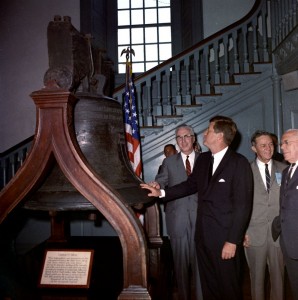My grandmother was cleaning her porch windows that Friday in November of 1963. A neighbor bounded out of his house with the news, running along the string of Philadelphia row homes until he arrived at my grandmother’s front windows.![]()
“Margaret! He’s been shot. President Kennedy was shot,” he exclaimed. To her disbelief, she turned on her TV only to face a matching uncertainty. Over fifty years later, she recalls the deep gravity of the situation, the momentary ambiguity of the state of the nation’s President. She watched with hands shaking until shortly after President John F. Kennedy was pronounced dead.
She didn’t vote for Kennedy, although her immediate memory suggested otherwise. “Of course I voted for him,” she answered. A moment lapsed until she remembered that she couldn’t have voted for the Irish Catholic Democrat from Boston as much as she might have to. 1963 marked her ninth year as an Irish American immigrant, and she had not yet gained citizenship. Still, she spoke of Kennedy with a certain tenderness; he wasn’t just America’s president. He was a president of her people: Irish Catholic immigrants.
![]() “They got it terribly hard, and they were terribly good Catholics. I’m not saying the president and the wife, but the president’s mother Rose. She went to mass every morning,” she said. She remembered that his grandparents emigrated from County Limerick of Bruff in western Ireland; her family back in Donegal loved him as if he were their own leader. For her and other Irish Catholic immigrants, Kennedy represented the tie between Ireland and America and offered a hope of success in the land of opportunity.
“They got it terribly hard, and they were terribly good Catholics. I’m not saying the president and the wife, but the president’s mother Rose. She went to mass every morning,” she said. She remembered that his grandparents emigrated from County Limerick of Bruff in western Ireland; her family back in Donegal loved him as if he were their own leader. For her and other Irish Catholic immigrants, Kennedy represented the tie between Ireland and America and offered a hope of success in the land of opportunity.
My grandmother was 34 years old the day of the assassination. Her husband was at work, and she spent her days at home taking care of her two young children. Though she emigrated nine years prior, her home was decorated with memories of Ireland. Irish flags, pictures of relatives, a painting of the Irish countryside above her mantle – she placed Catholic paraphernalia on every open surface, every wall so as to keep God and her country close to her heart. Yet, somewhere amongst her collections of home, she kept pictures of President Kennedy, dozens of pictures of an American man that she couldn’t have even voted for. Of these pictures, she most recalls a picture of Kennedy that portrayed him with the divine.
“Oh yeah. It was taken with him. It was a holy picture. They put Jesus or God next to John in the picture. I had one of them, but I don’t know what happened to them,” she said. In her eyes, the Kennedy family was a nice family, a family struck by tragedy and forever martyrs to America. When asked about the assassination, she most engaged with Jackie’s experience.
![]() “The sad thing about it was his wife, Jackie, standing next to the vice president… and her skirt was covered with blood. She held the president’s head when he was in the car and she kept it on – she wanted the whole world to see what they went through, and she was right to do it. And to see her face – she was in another world; she was in shock. I’ll never forget. It was the worst weekend. Jackie was the same age as me, same month, same year,” she said. Like many Americans struck by the tragedy, she identified with the Kennedy family. She saw herself as Jackie, her young children as the Jackie’s children; the assassination didn’t only mean a loss of a nation’s leader, it was a personal loss of a family made personable to Americans.
“The sad thing about it was his wife, Jackie, standing next to the vice president… and her skirt was covered with blood. She held the president’s head when he was in the car and she kept it on – she wanted the whole world to see what they went through, and she was right to do it. And to see her face – she was in another world; she was in shock. I’ll never forget. It was the worst weekend. Jackie was the same age as me, same month, same year,” she said. Like many Americans struck by the tragedy, she identified with the Kennedy family. She saw herself as Jackie, her young children as the Jackie’s children; the assassination didn’t only mean a loss of a nation’s leader, it was a personal loss of a family made personable to Americans.
My grandmother spoke of President Kennedy in her strong Irish brogue decades after his assassination with an almost palpable nostalgia. The young president was a symbol of hope and success in America for Irish Catholic immigrants, a figure that represented success for those seeking it in an unfamiliar country. The Kennedy legacy has lived on in the hearts of those of that time as an embodiment of family and tragedy in American history.
